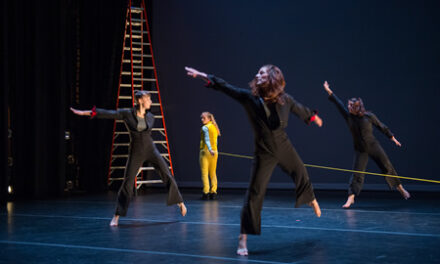By Nicholas Rich
April 28, 2017, Greensboro, NC: In Central North Carolina, an unlikely duo is exploring the boundaries of multimedia art. Flutist Krisztina Dér and videographer Wayne Reich have joined forces for And Then There Was Light, an intermedia project combining contemporary flute music with lighting concepts.
Dér’s interest in combining sound and light began when she performed George Crumb’s 20th-century masterpiece Vox Balaenae. In his score, Crumb asks the performers wear masks and perform under blue lighting. “I’m fascinated by the idea of utilizing light and sound — both forms of kinetic energy — in a single, synergistic work of art” says Dér.
While pursuing her M.M. degree at the University of North Carolina School of the Arts, Dér delved deeper into the intersection of flute and light by commissioning Michael Rothkopf‘s “I Dream of Coloured Inks.” Now completing her doctoral studies at the University of North Carolina at Greensboro, Dér has devoted her dissertation research and performance energy to this project, commissioning a further four pieces.
Dér found a like mind in Reich, a photographer, videographer, and musician interested in the potential of merging the aural and visual. “Krisztina and I met over coffee” says Reich, “and our ideas about music and light seemed to line up so well.”
In addition to the original Rothkopf composition, the project includes works by Anna Meadors, Jacob Thiede, Kyle Rowan, and Stuart Saunders Smith. Dér asked each of the composers to include a lighting concept as part of the piece. The results encompassed a huge variety of aesthetic and technical realms.
“In Dr. Rothkopf’s piece, the lighting is controlled by a computer program that is connected to three lighting units” explains Dér. “In the Meadors, a lighting technician executes the lighting design by controlling a lighting board. And in the Smith, the lighting element is performed by eight ‘lumanists,’ or individuals holding flashlights.”
Reich brought the project to life with compelling and carefully-staged video productions. His role was more than to document; Reich brought his artistry to bear on the complex task of rendering spatial art in video.
“My goal was to serve the music and each composer’s intention by creating a cinematic video of Krisztina’s performances while working around the constraints of the lighting design already in place” says Reich. “Most of my creative expression came in the form of camera position and operation, lens selection, editing, and color-grading. In a few places, I employed supplementary lighting where necessary.”
Three of the five pieces are by composers with ties to North Carolina. Rothkopf is on the composition faculty at UNCSA, while Thiede and Meadors both completed Master’s degrees at UNCG.
Rothkopf is known for designing sophisticated audio software that interacts with live performers. “I Dream of Coloured Inks” expands this concept by using interactive software to create both an electronic sound accompaniment and visual responses to two flutists. This is a crafty, angular piece characterized by shimmering metallic sounds from the computer and wonderfully jagged melodies in the flutes. The lighting is warm, soft, and immersive, enveloping both stage and musicians.
Jacob Thiede, currently a doctoral student at the University of North Texas, also used software to create his piece, “And Everything In-Between.” Thiede crafts a rich aural tapestry by not simply pairing digital and acoustic, but actually mixing them: the electronic accompaniment uses recorded and processed flute samples to spread out the performer’s sounds both spatially and temporally. As the sounds fragment, so do the projections. Mysterious blues and greens blink on and off rapidly in simulated malfunction and decay.
Anna Meadors, a PhD student at Princeton, chose an entirely acoustic landscape with “At Daybreak.” Don’t let the lack of computer fool you: by specifying timbral effects in the flute and adding a live percussionist, Meadors builds a powerful sonic fabric. Mirroring her approach to the music, Meadors asks a live lighting engineer to accompany the musicians. With every artistic element controlled in real time by human hands, “At Daybreak” has a wonderful elastic quality.
And Then There Was Light is a bold and compelling project. Asked to summarize her goals, a humble Krisztina Dér looks outward to her community.
“I hope to stimulate further adventures in music and light intermedia as a holistic art form — both for performers and composers.”
Note: See installments of the project as they are released at Krisztina Der’s blog: https://krisztinader.com/blog/.












